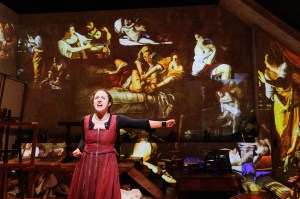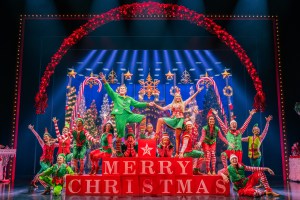
(Photo © Joan Marcus)
First-class productions of the Jerry Herman-Jerome Lawrence-Robert E. Lee musical Mame are rare, so the Kennedy Center’s new staging of the show was hotly anticipated by musical theater buffs — especially since it stars Christine Baranski and Harriet Harris, two theater veterans who are also beloved by the general public for their TV work. It’s a pleasure to report that this Mame is fabulously entertaining in spite of some miscasting and a few other flaws.
Based on the semi-authobiographical novel Auntie Mame by Patrick Dennis and the subsequent play and film of the same title by Lawrence and Lee, the musical has a title role that is calculated to give producers and casting directors agita. Aside from being a triple-threat singer, actress, and dancer, any woman who accepts the challenge of the part has to be beautiful and glamorous. She must have the comedic skills to properly deliver the script’s many zingers, but she also needs to project great warmth and love in her scenes with her young nephew, Patrick Dennis. (Any production of Mame in which those scenes don’t work is for naught.)
Christine Baranski is well nigh perfect for the part and scores a stunning success in it. That she is one of the funniest women on the planet Earth isn’t news to anyone who enjoyed her on Cybill or in the City Center Encores! production of Promises, Promises, in which Baranski famously got a laugh on every single line spoken by her character, Marge MacDougall. The question was whether or not she would have the other qualities necessary for Mame, and the answer is: Yes she does, in spades. Baranski lacks nothing in terms of vocal or dancing ability; she’s wonderfully glamorous; and as for the warmth factor, one couldn’t ask for more. Her performance can be mentioned almost in the same breath as that of Angela Lansbury, the peerless original interpreter of the role.
No less marvelous is Harris, who has made the risky but ultimately smart choice of playing Vera Charles not as a whisky-voiced, deadpan baritone but as an attention-grabbing, frequently braying First Lady of the American Theater. In doing so, she makes the role her own rather than slipping into the mold established by the amazing Beatrice Arthur. One example of Harris’s brilliance: She sings the verse of the “Moon Song” an octave up from where it’s written, which makes it all the more hysterically funny when she then drops down to the vocal basement for the chorus. Her comic chemistry with Baranski is a wonder, and their “Bosom Buddies” duet had the Kennedy Center audience in stitches.
Of the other players, the most enjoyable are Jeff McCarthy as a suave Beau Burnside; Mary Stout as his formidable mother; Alan Muraoka as the ever-helpful Ito; and Max von Essen in the relatively thankless role of the post-pubescent Patrick Dennis. Ruth Gottschall is not really the right type for Mrs. Upson, but her pratfall off of a couch in Act II is so hilarious that no one will mind. Harrison Chad — whom you may know as the original juvenile star of Broadway’s Caroline, or Change — is charming and displays a lovely singing voice as young Patrick, but he’s a little too mature and too tall for the assignment. Emily Skinner is appealing and sort of funny as Gooch but entirely wrong for the role from a physical standpoint. And Sarah Jane Everman is humor-free as Gloria Upson, eschewing the lockjaw Connecticut accent that’s part and parcel of the character but failing to come up with a viable alternative.
It’s unfortunate that director Eric Schaeffer didn’t help Everman find a character. Indeed, his direction of the show is so assured overall that one can only wonder at the few instances of miscasting and misguidance noted above. Warren Carlyle’s choreography is generally top drawer, as the Upsons might say, although the first section of “Open a New Window” could be wittier. Musical director James Moore seems to be having the time of his life conducting a magnificent 22-piece orchestra, and the results are thrilling; Herman’s terrific score, presented here in the original, nonpareil orchestrations by Philip J. Lang, deserves no less.
As for the physical production, it’s great. Set designer Walt Spangler lets his imagination run wild in showing us the ever-changing motifs of decor in Mame’s apartment, and Gregg Barnes’s costumes — including 16 for the leading lady alone! — are gorgeous. Ken Billington does a generally excellent job of lighting it all, though there were a few occasions when people descending the long, curved staircase that dominates the apartment scenes were in shadow during the opening night performance. Peter Hylenski’s sound design is exemplary, proving that if you have a wonderfully full orchestra on hand, you don’t have to pump up the volume to a ridiculous level.
By the way, the show suffered from some technical glitches at the opening, most of them minor but one of them disastrous. In the “Moon Song,” Mame — having been hired for a cameo role in the “terribly modern operetta” in which her pal Vera is starring — is supposed to rise above the stage on a crescent moon (and then make a fool of herself). But when the scene began in Thursday night’s performance, the moon was already in place with the empty seat clearly visible, so Baranski’s Mame never rose upon it. Instead, she stuck her head up from behind the scenery — barely visible to the audience — and warbled a few notes. Fiasco!
I’m told that the moon worked properly on Friday night. Pity that it had marred the official opening of a production so superb overall that its significant flaws somehow seem almost entirely insignificant.









